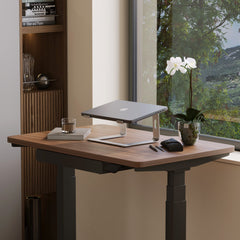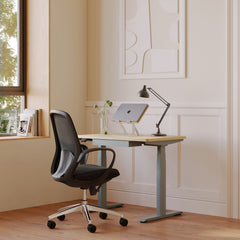Get 10% off your first order
Find the office furniture that’s designed to match your style, comfort, and needs perfectly. Subscribe
A Fresh Start: How to Revive Your Workspace Without Starting Over

Visit quiz page to see how we makes it easy to create an inspiring workplace


Your desk is more than furniture—it’s the center of your workflow and your well-being. The way your table is built and positioned can influence how you sit, stand, focus, and rest. In a world where long hours blur the lines between work and life, smart design helps bring those boundaries back into balance.
Work-life harmony isn’t about strict separation—it’s about flow. The right furniture encourages flexibility, movement, and comfort so your workspace adapts to you, not the other way around.
Balance in design isn’t only about symmetry—it’s about creating a physical environment that supports mental ease. When your desk and chair align correctly, your body can maintain comfort, and your mind stays focused.
A workspace that adapts to both sitting and standing.
Surfaces designed for comfort and reach.
Organization that supports workflow instead of cluttering it.
Visual simplicity that promotes calm concentration.
Balance is built through thoughtful design that blends productivity with comfort.
A healthy setup promotes small, consistent movements throughout the day. Sitting all day strains your back, while standing too long can fatigue your legs. A flexible layout like the Small Standing Desk New Jersey supports natural transitions between positions, helping you stay alert and comfortable.
|
Goal |
Action |
Benefit |
|
Reduce fatigue |
Alternate between sitting and standing |
Improves circulation |
|
Increase focus |
Move every 45 minutes |
Refreshes concentration |
|
Prevent stiffness |
Adjust desk height |
Eases tension in muscles |
|
Stay comfortable |
Keep posture dynamic |
Reduces back pain |
Movement doesn’t interrupt productivity—it enhances it.
Your workday has multiple phases—some call for deep focus, others for collaboration. Smart table design accommodates this shift.
Keep key tools accessible without cluttering the surface.
Use modular layouts for project-based flexibility.
Maintain open space for creative or collaborative sessions.
Include multi-use storage for changing needs.
Furniture that adapts helps you work fluidly between tasks and energy levels.
Good table design starts with your body in mind. Poor posture reduces oxygen flow and energy levels, while supportive design restores focus. Combining the right chair and desk creates long-term comfort.
Sit with your feet flat on the floor.
Keep elbows bent at 90 degrees.
Place your monitor at eye level.
Relax shoulders and avoid leaning forward.
For deeper insight into healthy seating, refer to this ergonomic chair guide that explores the science of support and posture.
Visual noise leads to mental fatigue. A clean, minimalist workspace keeps your attention on what matters most. The fewer distractions around your desk, the more energy your mind has for creativity.
Keep only essential items visible.
Use hidden storage to reduce visual chaos.
Keep cables neatly managed.
Clear your desk at the end of each day.
When your workspace is clear, your thoughts follow the same pattern—steady and uncluttered.

Design harmony isn’t just visual—it’s sensory. Materials and finishes influence how your workspace feels. Wood adds warmth, metal provides strength, and neutral colors maintain calm focus.
|
Material |
Feel |
Ideal Use |
|
Wood |
Warm, organic |
Tabletop surfaces |
|
Metal |
Structured, strong |
Desk legs or frame |
|
Glass |
Light, open |
Smaller spaces |
|
Fabric |
Soft, grounding |
Chair support or storage |
The right materials create an environment that encourages both focus and peace.
Design plays a powerful role in how your mind processes energy. A standing desk that encourages small adjustments helps sustain alertness. When form and function work together, your furniture becomes an active part of your focus.
Use neutral tones to keep visual calm.
Keep lighting consistent throughout the day.
Organize your desk according to your workflow.
Create a routine of posture changes.
Balance turns work from draining into fulfilling.
According to an ergonomic study, ergonomically designed furniture improves focus and reduces strain by supporting the natural movement of the body. Balanced environments don’t just protect health—they enhance creativity and decision-making.
Proper alignment decreases discomfort and fatigue.
Adjustable setups improve cognitive performance.
Healthy posture supports better mood regulation.
Ergonomic spaces promote long-term engagement.
Research continues to prove that balance between comfort and function leads to stronger, happier performance.
Collaboration doesn’t stop at the office—it thrives at home too. A clean, modern office desk with enough room for two promotes shared creativity while maintaining individual space.
Keep shared tools like boards or screens accessible.
Maintain personal boundaries with dedicated sections.
Use natural light to support shared focus.
Keep seating flexible for easy conversation.
Balance allows collaboration without sacrificing calm, even in compact home settings.
Smart furniture design encourages both teamwork and individuality. A quad workstation supports multiple people while giving each a defined workspace.
Equal spacing fosters fairness and focus.
Shared storage keeps clutter minimal.
Consistent design promotes harmony.
Open layouts make collaboration natural.
When everyone feels supported, collaboration flows more freely—and balance becomes collective.
Your table design influences more than posture—it affects your emotional state. Balanced setups give a sense of control and calm that carries beyond the workspace.
Reduces anxiety and visual stress.
Encourages steadier breathing.
Promotes smoother task transitions.
Creates an uplifting work environment.
A harmonious space nurtures the kind of peace that translates directly into better performance.

A well-designed workspace adapts to your life. It gives you the flexibility to move, think, and connect seamlessly. Smart tables and chairs are more than furniture—they’re tools that bring physical and mental balance to your workday.
Design supports both focus and rest.
Ergonomics protect energy and creativity.
Balance in layout equals balance in life.
Smart furniture design enhances how we live and work.
When balance becomes part of your workspace, work no longer feels separate from well-being—it becomes part of it.

A Fresh Start: How to Revive Your Workspace Without Starting Over

Style Meets Function: How to Accessorize Your Office Table Like a Pro

The Clear Space Effect: How Simple Furniture Boosts Productivity
Get 10% off your first order
Find the office furniture that’s designed to match your style, comfort, and needs perfectly. Subscribe
Leave a comment